Christmas in South America
Christmas in South America is a bright, colourful holiday. It is celebrated with lot of passion. Similarities between countries are due to the fact that most people in Latin America are Roman Catholics.
Christmas tree in Argentina does not have to be a coniferous one. People decorate all kind of trees. Christmas in Argentina is celebrated in summer. But many miss winter and snow which is by most people associated with Christmas. People make cotton balls symbolizing snow. They put them on their Christmas tree. Almost every house prepares their own nativity scene or "pesebre". Pesebre is put next to Christmas tree. Pesebre exists all over South America.
In Argentina the most popular drink for Christmas and New Year celebration is cider or sidra. Cider is a drink made from apple juice. Very popular Christmas dish in Argentina is "Niños envueltos". This dish is made of steaks filled with minced meat, spices, boiled eggs and onions. Each steak is shaped into rolls and then baked or simmered.
The same as all over the world, kids in Chile love Santa Claus. They call him "Viejito Pascuero" or "Old Man Christmas". He is quite small. That way he can easily move down the chimney. Chimneys in Chile are not so big like elsewhere in the world.
"Cola de Mono" or "Monkey's Tail" is a very popular Chilean drink. Many people drink it during Christmas holidays. The drink contains aguardiente, rum, coffee, milk and anise.
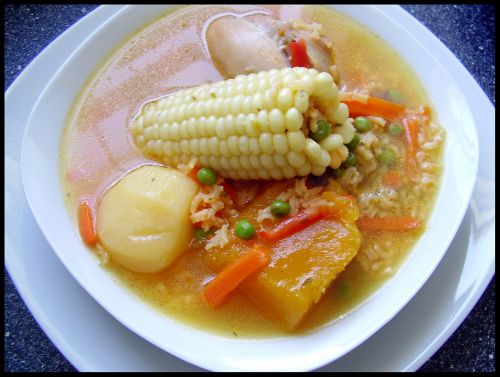 Cazuela de Ave
Cazuela de Ave
Popular Chilean Christmas dishes are "Cazuela de Ave" and "Pan de Pascua". Cazuela de Ave is a chicken soup with potatoes, onion and corn. Pan de Pascua is a cake made of candied fruits, raisins, walnuts and almonds. It was brought to Chile by German immigrants.
In the week preceding Christmas religious and other organizations and communities of Cusco, Peru organize so called "chocolatadas". Poor children get a cup of hot chocolate and maybe a small present.
In Peru nativity scene also includes a "retablo". Retablo is a small Latin American devotional painting. It is a form of popular or folk art. In the past priest, when travelling to local church festivities, used to carry small altars. Saints were shown above the altar and groups of so called ordinary people below it. Nowadays retablos depict Mary, Joseph and baby Jesus, plus groups of people watching them.
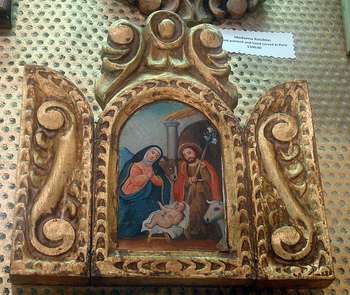 Retablo
Retablo
Christmas Eve ("Noche Buena") meal in Peru includes turkey ("pavo"), apple sauce, paneton etc. In Peru presents are exchanged on the Epiphany or "la Bajada de los Reyes", on the 6th January, which is the end of Christmas season.
Exactly at midnight on Christmas Eve Bolivians set off firecrackers. People of Bolivia have their big Christmas meal when they return from the Midnight Mass or "Misa del Gallo" (Mass of the Rooster). It is also possible to have a meal on Christmas Day. Many different dishes are served. Here are just few examples. "Picana" is a soup made of chicken meat, beef, corn and different spices. People also enjoy "Turrón", which is a nougat delicacy made of honey, sugar, egg white and almonds.
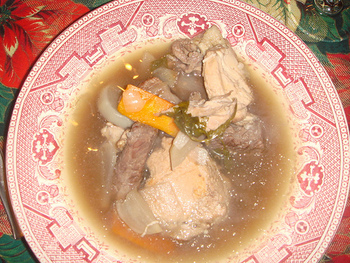 Picana
Picana
Christmas morning is time for "Natilla" and "Buñuelos." Natilla is a custard-like pudding made with corn starch. Buñuelos are fritters with some white cheese inside. Bolivians also have something what is called “Canastón". Canaston is a big basket or plastic tub filled with basic food products like for example bread, sugar, rice, biscuits etc. It is given to employee by his or her employer.
In Colombia Christmas season starts on the 7th December, which is the day of “La Virgen de la Inmaculada Concepción” or "The Virgin of the Immaculate Conception". People in Colombia also call it “El Día de las Velitas” or "The Day of Candles". On that day people light lines of thin candles in front of their homes, churches etc. Everybody is having a good time. There is lot of food like "Buñuelos" (fritters) and "Empanadas". Epanadas are kind of baked or fried pastry filled with potatoes or meat. People often drink an anise beverage called "Aguardiente”.
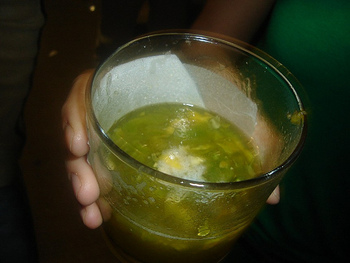 Aguardiente
Aguardiente
Each night from 16th until 24th December people in Colombia pray “La Novena de Aguinaldos”. Through this prayers people spiritually get closer to true meaning of Christmas. People also sing "villancicos" or Christmas carols. The novena can be organized by several families or it is hosted by grandparents.
During whole month of December people in Colombia often make lot of fireworks or “quema pólvora”. There is also a tradition of "elevar globos" or "elevating the globes". Paper globes are lit from the inside and let fly up in the sky.
In Ecuador there are beautiful Christmas day processions. Groups of natives walk from their mountain homes with decorated llamas. They bring fruit and other stuff to ranches owned by their employers. There they put them in front of the pesebre which is set there. Children recite poems to the Holy Infant and ask for blessing for their families. Employers then give presents to their employees. There is a big party with lot of lamb meat, potatoes and special bread.
The same as in Colombia people also pray the Novena, starting from the 16th December. Few days before Christmas Eve figure of the Holy Infant is covered with a veil. The veil is removed on Christmas Eve. This act symbolically represents the birth of baby Jesus. In Ecuador traditional Christmas meal includes turkey, pig, "pristiños" (ring-shaped pastries) etc.
A month or even more before Christmas kids in Ecuador write "a letter to the baby Jesus”. In this letter kids write about their behaviour in the past year and wishes for Christmas presents they would love to get. Ecuadorians use Cypress as their Christmas tree.
"Aguinaldos" are traditional songs performed during Christmas season in Venezuela. Musical instruments used in these songs are the "cuatro" (a small guitar), the "maracas" (rattle) and the "furruco" (a small drum). Masses held on nine mornings before Christmas are rather unusual. People often arrive on roller-skates.
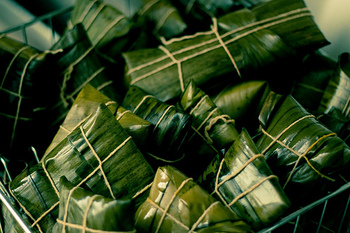 Hallaca
Hallaca
Like everywhere else tables on Christmas Eve in Venezuela are filled with different dishes. "Hallaca" (hayaca) is a boiled or steamed mixture of beef, pork, chicken, capers, raisins, and olives wrapped in cornmeal dough. Everything mentioned is bound with string within plantain leaves. "Pan de jamón" is a bread filled with cooked ham and raisins. "Dulce de lechoza" is a delicacy made of papaya and brown sugar.
Children in Surname get presents from "Goedoe Pa" or "Dearest Daddy"). Goedoe Pa is a black man. He has a group of black servants. They travel throughout Suriname delivering presents. To draw their attention local children prepare some cookies and milk. On the 6th December children find some presents and poems in their shoes. It was not always so. Until 1975 Suriname was Dutch colony. So, then even Christmas traditions were more or less the same as in the Netherlands. Christmas presents were brought by Saint Nicholas or "Sinterklaas". He was an old white man who arrived to Surname by ship on the 5th December, just a day before his festival. He rode a white horse. He had a group of black servants. Children used to leave some hay and carrots in their shoes for Saint Nicholas' horse.
Few weeks before Christmas people in Guayana start the “breaking up of the house”. People clean their house, top to bottom. The number one delicacy served for the Christmas meal in Guayana is the "black cake". The preparation of this dark, dense cake starts about two months before Christmas. One reason for this fact is that locals send little bit of cake to their cousins living abroad. To make the cake fresh for a long time people use lot of rum in its preparation. Fruit used in this cake has to be soaked in rum for over three months.
Other delicacies people in Guayana eat at Christmas meal are garlic pork, pepperpot, pickled onions and ham. There are also drinks like ginger beer, "mauby", "sorrel", different kinds of "fly", "falernum", shandy etc. During Christmas locals organize big parades with masked dancers and drummers. Various characters like for example Cow, Long-lady (her nickname is Boom Boom Sally or Mother Sally) and Long Man participate in such parades.
The Presépio or Nativity scene is especially popular in the northeast of Brazil. The first Presépio was made in the 17th century in the city of Olinda, Pernambuco by the Franciscan friar Gaspar de Santo Agostinho. In the north of Brazil people perform a play called "The Shepherds". What differs Brazilian version of this play from that existing in Mexico is the fact that Brazilians have shepherdesses and a gypsy who try to kidnap Baby Jesus.
"Papai Noel" (Father Christmas) is the one who brings presents. Due to hot weather Papai Noel wears silk clothes. There is also a lovely tradition organized among friends and family. It is called "amigo secreto" (secret friend). At the beginning of December all those participating write their name on a piece of paper. Then each person takes one paper but does not reveal whose name is written on it. In the following weeks messages are exchanged. To hide their true identity people use "apelidos" or false names. On the Christmas Day participants gather, reveal who their secret friends are and give them special presents.
Because of high crime rate in many of Brazilian cities tradition of attending midnight mass or "Missa do Galo" is nowadays less common. Instead people go to masses held in the late afternoon or early evening. There is a tradition of having a special midnight supper or "ceia".
Christmas meal in Brazil includes dishes like turkey, ham, coloured rice, lot of different fruit and vegetables. Especially in the south of Brazil lot of people include many Christmas traditions of the countries their ancestors arrived from. Good example are people of Italian or German origin. All of Brazilian cities have big Christmas trees with electric lights. The most popular Christmas song in Brazil is "Noite Feliz" ("Silent Night"). Brazilians have Christmas songs of their own but they are not that popular.